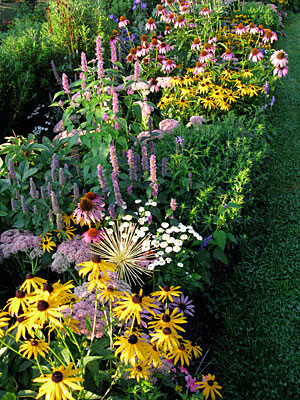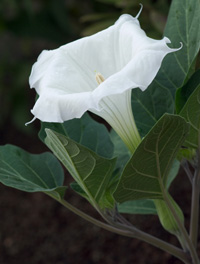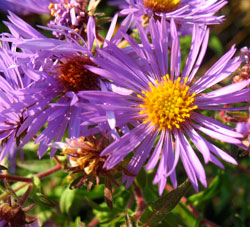





As a founding employee of Gardener's Supply, I wore many different hats over the years. Currently, I have my own company called Johnnie Brook Creative. The gardens around my home in Richmond, VT, include a large vegetable garden, seasonal greenhouse, cutting garden, perennial gardens, rock garden, shade garden, berry plantings, lots of container plants and a meadow garden. There's no place I'd rather be than in the garden.

The alliums, peonies and delphiniums are long gone, but as you can see here, my garden is even more colorful in August. Front to back: Rudbeckia hirta (black-eyed Susan), Sedum ‘Autumn Joy’, Tanacetum parthenium (matricaria), Agastache foeniculum (anise hyssop) and Echinacea purpurea (coneflower). That yellow allium in font? It's one of our Everlasting Alliums.
It's hard to imagine my flower gardens without Oriental poppies, lupines, bleeding heart and other early summer perennials. Each has its own beauty and charm, and I eagerly anticipate their annual appearance.
But when bloom-time is over, many of these perennials call it quits and all but disappear until next spring. A place in my garden that was lush and colorful last week suddenly begins a steep decline toward withered and brown. Other awkward gaps also start appearing in midsummer. A new plant may not get as big or as full as expected. Pests or disease can cause problems. An old plant may weaken and die.
In a perennial garden, these late-season gaps are almost impossible to avoid. Public gardens with large perennial borders, keep their staff gardeners busy all summer long, filling gaps with fresh plants from their greenhouses and nursery areas. And I know from my own experience at Gardener's Supply, that when catalogs and magazines photograph a summer perennial garden, there are always extra potted plants in the wings, waiting to step in.
Here are a few of the techniques that I use to fill, hide or disguise the midsummer gaps in my own perennial garden:

Datura is an annual that's capable of filling a large gap with silvery-green leaves and huge, white flowers.
Add a few annuals. Unlike perennials, annuals have just one year to live and they usually make the most of it by growing quickly and flowering abundantly from midsummer right up to frost. By using annuals to fill some of the gaps in your perennial garden, you'll add color as well as foliage.
These days, most good-size garden centers maintain an inventory of annuals right into early August. Increasingly, you'll find annuals in bigger size pots, too. The 2-quart or gallon-size "jumbo annuals" usually suffer little if any transplant shock when you move them into your garden. Just make sure they get watered frequently for a couple weeks while their roots are getting settled into your soil.
Don't fail to consider some of the great foliage plants available these days, such as coleus, plectranthus, fancy-leaved cannas and other tropicals.
To learn more about which types of annuals work best in perennial gardens (and why you'll probably want to avoid petunias and zinnias), read Late-Summer Flowers.

Fall-blooming perennials, such as asters, add late-season color.
Add some perennials. By midsummer, most nurseries and garden centers have put their perennials on sale. Another good thing about shopping for perennials in late July and early August, is that it's easy to see what's blooming at that time of year. Picking up a few new perennials will help you fill the gaps in your borders, while introducing good, late-season color that you'll enjoy in subsequent years.
Acquire more fall-blooming plants. There are some perennials that look their best in August and September. Since most plant-buying happens in May when these fall-bloomers don't look like much, the typical perennial garden is short on late-season color. So while you're cruising for deals at your local garden center or nursery, consider picking up asters, mums, sedum, helenium and monkshood. If you're lucky, you might also be able to find flowering kale or flowering cabbage. These plants can look a little batty early on, but you'll be patting yourself on the back when they're looking fabulous in early November.
Move in some pots. At the beginning of the season, I usually pot up a dozen or more decorative planters. Of course it's not that I "need" or even have room for that many pots. There are just so many interesting plants that suggest so many wonderful combinations. If you have a couple extra mid-size containers planted up, try using one of them to fill a gap in your perennial garden. You can't do this in more than a few places in the garden, and not every planter will work, but you might be surprised by the effect. Look closely at the gardens featured in magazines such as Horticulture and Martha Stewart Living, and you'll see how often they use this technique.
Move the art around. I have a couple large gazing globes in my garden. I also have two small stone water basins and a few life-size concrete turtles and bunnies. It might be a bit presumptuous to call these accessories "garden art" but that's how I think of them. I also consider benches, chairs and birdbaths garden art, and in my garden, almost all of these features are mobile.
The stone basin that looks great next to the primroses in early spring, would get completely hidden by the hostas, so I move it into the gap left by Jacob's ladder. I use the steel globe in the same way. A large one remains in the shade garden until the hostas and lady's mantle fill out, then it's available for hiding problems elsewhere. When all else fails, sometimes the best strategy is to just draw the eye away from the problem and let it rest on something like a sculpture or bench.
Copyright © www.100flowers.win Botanic Garden All Rights Reserved